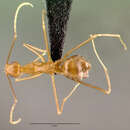The yellow crazy ant
Anoplolepis gracilipes, also known as the long-legged ant or the Maldive ant, is one of the five species of “tramp ant” species, known for invasive behavior and devastating ecological effects. The Invasive Species Specialist Group (ISSG) considers it among
the top 100 of the world’s worst invaders. Its native origin is not certain, but thought to be either in West Africa or Asia; it has been introduced across the world’s tropical and sub-tropical areas, including many Pacific Islands, Northern Australia, the Carribean, and some Indian Ocean islands. Perhaps its most notorious devastation is on Christmas Island, where it caused an “Invasional meltdown” (O’Dowd et al 2003), decimating red land crab (
Gecarcoidea natalis) populations, a keystone species whose demise has significantly altered the islands ecology and negatively effected endemic species. There is grave concern about spread of
A. gracilipes in northern and north-eastern Australia, where a huge eradication campaign is underway. Several features of the yellow crazy ant contribute to its destructive ecological impacts: • It has a generalist diet and is a competitive forager, making huge colonies (in some cases “supercolonies” containing multiple queens) with enormous nutritional needs. It preys on or interferes with the survival of a large variety of rainforest arthropods, reptiles, birds and mammals. • It forms tight mutualisms with sap-sucking scale insects, boosting scale populations and consequentially boosting sooty mold growth, both which negatively impact rainforest health. • It colonizes agricultural areas making it easily carried to new regions by humans in boats, road vehicles, and farm equipment. • It has a very rapid colony spread rate, in one instance on Christmas Island colony expansion was measured at 3 m/day. The yellow crazy ant is so called for its erratic, fast movements, especially when disturbed. For an invasive ant, this ant is large in size. It is yellow-orange in color and has long legs and antennae. (O'Dowd 2003,
2009;
PiaKey;
Wikipedia 2011)

